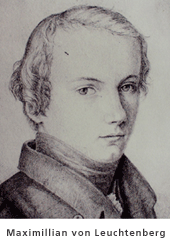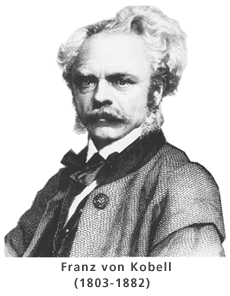History
The MSM is a collection with a great history. A whole series of diverse acquisitions formed the basis of a collection that to this day, despite many setbacks extending into the recent past, remains one of the great German mineralogical collections.
Paul von Groth, director of the State Collection since 1880, names the following collections in his guide to the State Collection, published in 1891, whose merging resulted in the holdings of that time:
- the Leuchtenberg collection from Eichstätt with particularly many and valuable Russian mineral specimens, e.g. gold specimens from the Urals, platinum nuggets, a variety of Russian gemstone minerals such as emerald, topaz, phenakite and tourmaline,
- the former electoral natural history cabinet from Mannheim
- a unique collection of silver ores from the Markirch mines owned by the Lords of Rappoltstein
- the mineral cabinet of the Bergeleven Institute in Munich.
- specimens from the ducal mineral cabinet at Zweibrücken with especially nice specimens of the rare mineral moschellandsbergite
- various donations by King Ludwig I, for example the meteorite from Schönenberg,
- already existent old collection holdings, especially minerals from the former Bavarian mines in today’s Tyrol and Salzburg,
- the collection of the mountain council of Hohenbalken from Innsbruck with about 4,000 pieces, including many beautiful alpine specimens,
- an extensive collection of Norwegian minerals, especially from the famous deposit district of the Langesundfjord, which could be purchased through the mediation of the then best expert of these minerals, Professor Brögger,
- Donations from the Bavarian Mining, Metallurgical and Salt Works Administration,
- Donations from the Directorate of Oberberg in Bavaria,
- Donations from the Royal Prussian Mining Administration in Staßfurt,
- as well as a large number of private donations.
Within this list, the Leuchtenberg collection stands out due to the quality of its pieces, a small part of which can still be seen today, and therefore special attention should be paid to its history.
The Leuchtenberg Natural History Cabinet at Eichstätt

The founder of the Leuchtenberg Natural History Cabinet was Eugéne de Beauharnais, son of Josephine de Beauharnais and stepson of Napoleon. He married Auguste Amalie, the daughter of the at that time Elector Maximilian Josef of Bavaria. Eugéne, who was Viceroy of Italy under Napoleon, had to flee after Napoleon’s defeat and settled with his family in Munich. In 1817, on the occasion of the birth of his son Maximilian, his father-in-law, the Bavarian king (Bavaria had been elevated to a kingdom in 1806), bestowed upon him the title of Duke of Leuchtenberg and Prince of Eichstätt. However, very little is known about the nature and extent of the mineralogical collections of the first Duke of Leuchtenberg, who died in 1824 at the age of only 42. The collection was continued by his eldest son August von Leuchtenberg. When his sister Amalie Auguste married the Brazilian emperor Dom Pedro I in 1829, he accompanied her on her trip to Brazil. There, his extensive collecting activities, which concentrated especially on minerals, were particularly promoted and supervised by his brother-in-law and some scientists accompanying him. The result were countless crates with excellent mineral specimens, which were sent to Eichstätt to enrich the Naturalienkabinett. After August’s sudden death at the age of 25, the title and collection passed to his younger brother Maximilian, who was also an avid mineral collector. In 1839, he married the Grand Duchess Maria Nikolaevna, a daughter of the Russian Tsar Nicholas I.
Duke Maximilian, who then had to move his residence to St. Petersburg, therefore devoted himself especially to Russian minerals. This interest also led to public offices in the field of Russian mining. As president of the Mining Engineering Institute in St. Petersburg, he made numerous inspection trips to various Russian mining areas, from where he brought back numerous mineral specimens. Especially the famous gemstone mines in the Urals and in Siberia were in their prime at that time. Despite his residence in Petersburg, Maximilian had most of the collected Russian specimens brought to the cabinet in Eichstätt, which aroused the admiration of all contemporaries, and was considered the best collection of Russian minerals in Germany. A mineral of the chlorite group was named Leuchtenbergite in 1842 in honor of Maximilian of Leuchtenberg. Original specimens of this mineral are still in the collection today. In Maximilian’s Petersburg collection there was an exquisite honey-brown topaz from the Russian gemstone mines, described by Koksharov, which could be the piece that can be seen today as Koksharov topaz in the collection of the Sorbonne. In 1852, Leuchtenberg’s mineral collection was considerably expanded by the purchase of the collection of the Munich physician Prof. Dr. Johann Nepomuk von Ringseis; with its approximately 7,000 specimens, it increased the number of pieces to more than 17,000. According to eyewitness reports, Ringseis’s collection alone is said to have far eclipsed the then already existing state collection in terms of the number and quality of the pieces. Particularly noteworthy pieces, which came to the Leuchtenberg mineral cabinet through this purchase, were some top specimens from the Bodenmais mine in the Bavarian Forest: From the Silberberg came excellent specimens with large crystals of cordierite and kreittonite (a zinc spinel).
Also the probably most valuable piece of the today’s collection, a large Russian emerald specimen, which looks for its equals in the museums of the world, comes from the former Leuchtenberg mineral cabinet.
The Bavarian State Collection for Mineralogy

After the death of Maximilian von Leuchtenberg in 1852, the principality of Eichstätt reverted to the Bavarian state, and thus the Eichstätt Natural History Cabinet also came into the possession of the state. After long disputes and competence conflicts between different ministries, which only ended after the intervention of the then head of the collection, Franz von Kobell, a word of power from the Bavarian king, the collection was brought to Munich in 1858, united with the already existing state collection and set up in its entirety.
Especially under the direction of Paul Ritter von Groth, the State Collection was systematically supplemented and expanded, so that by the end of Groth’s creative period it was one of the largest and most important collections in Europe.
In April 1944, the Mineralogische Staatssammlung was struck by a great misfortune. Contrary to the advice of many people involved, the collection had not been moved out of storage by the management of the time. During one of the numerous air raids towards the end of the World War II, the building in which the collection was housed was destroyed and more than 80 % of the collection was lost. In the process, pieces of immense scientific and material value were lost; besides large parts of the Leuchtenberg collection, only the outstanding Markirch proustite specimens are mentioned, which, according to contemporary judgments, represented the best existing collection.
In 1972, shortly before the move to the current building in Theresienstraße 41, the exhibition showcases were broken into. A large number of the best pieces were stolen, including Russian exhibits, which probably came from the Leuchtenberg collection.
Today, both the exhibition and the storerooms are equipped and secured according to the latest safety standards, so that such losses can no longer occur according to human judgement.

